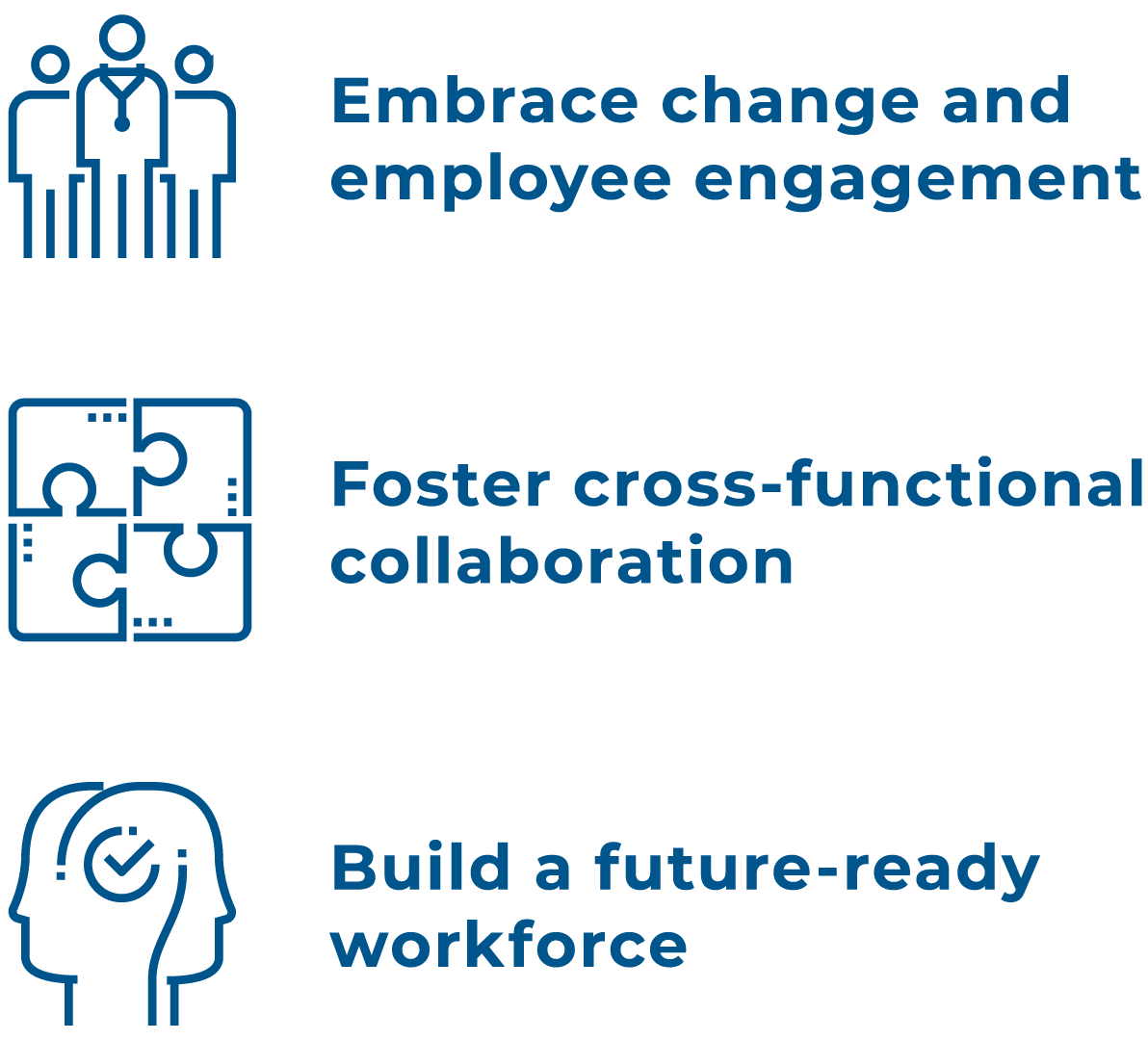In Brief
Embracing automation and digital transformation
- Automation and digital transformation are revolutionizing the energy and utilities industry, leading to the elimination of certain job roles and the creation of new ones.
- To succeed in the automated industry, organizations must embrace change, foster cross-functional collaboration, and invest in building a future-ready workforce through upskilling and reskilling programs.
- Change management and employee engagement are crucial components of this shift, requiring clear communication, employee involvement, an agile approach, and leadership support.
- The sector can look forward to a future of increased efficiency, innovation, and growth by embracing automation and its transformative potential, despite the reshaping of job roles and redefining of careers.
A wave of automation is transforming industries worldwide, and the energy and utilities sector is no exception. In this dynamic industry landscape, automation and digital transformation are paving the way for profound advancements. At the same time, they’re revolutionizing job roles and creating a dynamic shift in career paths within the industry.
To keep up with the pace of change in the industry, energy and utility companies must understand the role automation plays in reshaping their labor market, identify opportunities to further embrace emerging technologies, and help their teams adapt to changes in the current roles and future career paths.
Automation is more than just a buzzword; it's an agent of change, bringing about a paradigm shift in job roles and responsibilities within the energy and utilities industry.
The impact of automation on the energy and utilities industry workforce
Automation is more than just a buzzword; it's an agent of change, bringing about a paradigm shift in job roles and responsibilities within the energy and utilities industry. As systems become increasingly automated, employees are better able to focus their expertise on strategic tasks, elevating their roles beyond routine operations. But the benefits of automation extend beyond efficiency and accuracy; it can also significantly reduce risk, making workplaces safer and more secure.
In the energy and utilities sector specifically, automation has led to a dual effect – the elimination of certain job roles and the creation of new ones. Manual and repetitive tasks are being automated, reducing the need for human intervention and thus, certain roles. The most forward-thinking industry leaders consider this not a cause for alarm but an opportunity for evolution. As traditional roles phase out, new ones emerge (particularly in areas such as data analysis, system monitoring, and automation technology management), signaling an era of opportunity and growth.
A 3-pronged approach to adapting to an increasingly automated industry

The future of work in the energy and utilities industry hinges on the successful integration of automation and digital transformation. These technological revolutions offer immense potential for efficiency gains, risk reduction, and innovation. To harness these opportunities, organizations must embrace change, foster collaboration, and invest in building a future-ready workforce. This forward-thinking approach will ensure that they thrive in the digital age and set new standards for operational excellence and sustainability.
Help workforces embrace change
Change management and employee engagement are also crucial components of this shift. By fostering a culture of openness and inclusion, organizations can ensure that employees feel valued and involved in the transition. Regular feedback sessions, recognition of efforts, and clear communication help maintain morale and motivation during periods of transformation.
Change management is a critical consideration for energy and utility companies as they navigate the transition toward an increasingly automated industry. Successful change management can ensure smoother transitions, minimize resistance, increase engagement, and improve the overall effectiveness of new systems and processes.
A few key considerations:
- Clear communication. It's crucial to communicate the reasons behind any automation clearly and transparently, outlining the benefits for both the company and its employees. Reasons can include improved efficiency, cost savings, and opportunities for employees to engage in more complex, value-adding tasks.
- Employee involvement. Encouraging employee participation in the change process can increase buy-in and reduce resistance. This can be achieved through workshops, focus groups, or task forces that allow employees to contribute their ideas and feedback.
- Agile approach. Implementing changes in smaller, manageable stages rather than a complete overnight overhaul can make the process less daunting and more adaptable. An agile approach allows for adjustments along the way based on feedback and learning.
- Leadership support. Leaders play a crucial role in driving change. By demonstrating commitment to the change and modeling desired behaviors, leaders can inspire their teams to embrace automation.
Effectively managing change requires a multifaceted approach. But with the right strategies in place, energy and utility companies can successfully guide their workforces through the transition toward an automated industry.
Foster cross-functional collaboration
Cross-functional collaboration fosters innovation. By bringing together diverse perspectives and expertise, it helps generate creative solutions to the complex problems posed by the integration of automation technologies. For instance, IT experts can work hand in hand with field technicians and managerial staff to develop and implement automation solutions that are technically sound, practical, and aligned with business objectives.
In the rapidly evolving energy and utilities sector, the ability to quickly adapt to new technologies and market conditions is crucial. Cross-functional teams, with their varied skills and knowledge, are well-equipped to respond to the changes that are to come. They can help ensure that the adoption of automation technologies is responsive to the needs of the company, its employees, and its customers. Fostering a culture of cross-functional collaboration also ensures that the impacts of automation on employees are carefully considered and managed and that employees are adequately trained and supported to work with new technologies. This can lead to increased employee engagement and satisfaction, and a smoother transition overall.
Accelerating oil and gas automation: Practical lessons from the front line
Learn from Andy Otterman, Tallgrass Energy Director of IT alongside Huron’s Scott Leshinski and Taylor Kennedy as they educate and share insight behind the process of transforming a business for automation.
Watch the webinar
Build a future-ready workforce
The changing landscape underscores the importance of reskilling and upskilling. As the industry evolves, individuals must adapt by acquiring new skills and competencies. Upskilling programs, training initiatives, and continuous learning opportunities help employees remain competitive in the evolving job market. By fostering a culture of continuous learning, firms can ensure they are equipped to navigate the complexities of the digital age.
Technical proficiency in emerging technologies like artificial intelligence (AI) and robotics will be in high demand, but so too will abilities such as critical thinking, adaptability, and creativity. Transferable skills – those abilities that are valuable across a variety of roles and sectors – are also important to consider. In the automated energy and utilities sector, collaboration and cross-functional teamwork will take center stage. As job roles evolve, employees have a unique opportunity to collaborate, innovate, and contribute to industry advancements.
To future-proof their careers, individuals must stay updated on industry trends, acquire in-demand skills, and actively network to future-proof their careers and open up new professional opportunities.
Automation is undeniably reshaping the labor market in the energy and utilities sector, bringing both challenges and opportunities. It’s not just reshaping job roles; it’s redefining careers.
The bottom line: Embrace automation to enable your competitive advantage
Automation is undeniably reshaping the labor market in the energy and utilities sector, bringing both challenges and opportunities. It’s not just reshaping job roles; it’s redefining careers. As job roles evolve and new technologies emerge, individuals and organizations must adapt and innovate. Embracing change, fostering collaboration, and building a future-ready workforce are key steps that will help energy and utility companies navigate these changes successfully and grow their competitive advantage.
While some positions may phase out, new, exciting roles are emerging, offering opportunities for growth and advancement. By embracing automation and its transformative potential, the sector can look forward to a future of increased efficiency, innovation, and growth.
